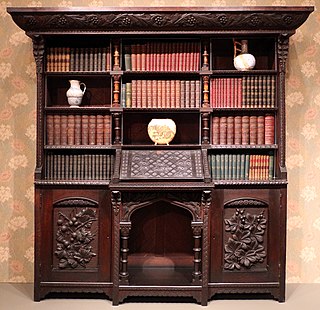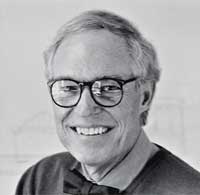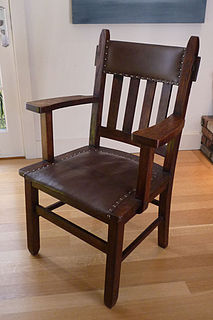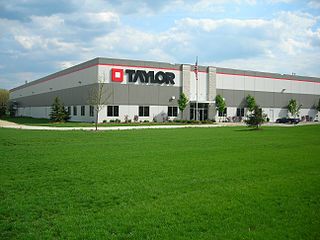
| Wikimedia Commons has media related to Lambert Hitchcock . |
Lambert Hitchcock (May 28, 1795, Cheshire, Connecticut – 1852) was an American furniture manufacturer, [1] famous for designing and mass-producing the Hitchcock chair.

Cheshire, formerly known as New Cheshire Parish, is a town in New Haven County, Connecticut, United States. At the time of the 2010 census, the population of Cheshire was 29,261. The center of population of Connecticut is located in Cheshire.

Furniture refers to movable objects intended to support various human activities such as seating, eating (tables), and sleeping. Furniture is also used to hold objects at a convenient height for work, or to store things. Furniture can be a product of design and is considered a form of decorative art. In addition to furniture's functional role, it can serve a symbolic or religious purpose. It can be made from many materials, including metal, plastic, and wood. Furniture can be made using a variety of woodworking joints which often reflect the local culture.
Hitchcock was the son of John Lee Hitchcock, an American Revolutionary War veteran who was lost at sea in 1811. He attended the Episcopal Academy of Cheshire, now known as Cheshire Academy, and was an apprentice to woodworker Silas Cheney. In 1818, he opened a furniture factory in Riverton, Connecticut, then called Hitchcocksville. The factory at first made chair parts. Soon Hitchcock, influenced by Connecticut clockmaker Eli Terry, began mass-producing simple, affordable chairs. Instead of painting designs on the backs, he used the relatively new and easier technique of stenciling. By the late 1820s, the Hitchcock Chair Company was producing over 15,000 chairs a year.

The American Revolutionary War (1775–1783), also known as the American War of Independence, was an 18th-century war between Great Britain and its Thirteen Colonies which declared independence as the United States of America.

Cheshire Academy is a selective, co-educational college preparatory school located in Cheshire, Connecticut, United States. Founded in 1794 as the Episcopal Academy of Connecticut, it is currently the tenth oldest boarding school in the United States. In 1917, the school was renamed The Roxbury School, and trained young men exclusively for the purpose of attending nearby Yale University. Later known as Cheshire Academy, the school was the first private academic institution to accept international students dating back to the 1850s, and it is currently the only independent school to offer the International Baccalaureate Diploma Programme in the state of Connecticut.

Eli Terry Sr. was an inventor and clockmaker in Connecticut. He received a United States patent for a shelf clock mechanism. He introduced mass production to the art of clockmaking, which made clocks affordable for the average American citizen. Terry occupies an important place in the beginnings of the development of interchangeable parts manufacturing. Terry is considered the first person in American history to actually accomplish Interchangeable parts with no government funding. Terry became one of the most accomplished mechanics in New England during the early part of the nineteenth century. The village of Terryville, Connecticut is named for his son, Eli Terry Jr.
Although an innovative manufacturer, Hitchcock was an unsuccessful businessman. His company went through receivership in 1832, with his brothers-in-law joining the business under the name Hitchcock, Alford & Co. In 1843, he sold his interest in the company and started a new company in Unionville, Connecticut, which also failed. He died in 1852 with little money to his name.
In 1946, John Tarrant Kenney came upon the abandoned Hitchcock Chair factory while fishing on the Farmington River. He wrote a biography, The Hitchcock Chair, and started a new Hitchcock Chair Company in the same location. That business lasted until 2006, when it was forced to close due to competition from low-cost overseas furniture manufacturers. In the spring of 2010, Rick Swenson and his business partner, Gary Hath, purchased the Hitchcock name, plans, and artwork, and began producing chairs. [2]

The Farmington River is a river, 46.7 miles (75.2 km) in length along its main stem, which is located in northwest Connecticut with major tributaries extending into southwest Massachusetts. Via its longest branch, the Farmington's length increases to 80.4 miles (129.4 km), making it the Connecticut River's longest tributary by a mere 2.3 miles (3.7 km) over the major river directly to its north, the Westfield River. The Farmington River's watershed covers 609 square miles (1,580 km2). The river historically played an important role in small-scale manufacturing in towns along its course, but it is now mainly used for recreation and drinking water. The Farmington River Watershed Association is a non-profit organization for conservation and preservation of this river.











